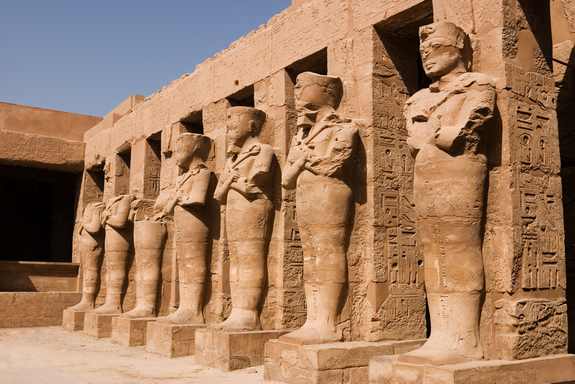Facts About the Karnak Temple
Prepare to embark on a journey through time as we delve into the captivating world of Karnak Temple, a magnificent testament to the grandeur and artistry of ancient Egypt. Situated on the East Bank of Luxor, Karnak Temple is a sprawling complex of awe-inspiring structures and sacred spaces that have stood for thousands of years. Let us explore the fascinating history, architectural wonders, and spiritual significance of this remarkable UNESCO World Heritage site.
The History of Karnak Temple: A Legacy of Pharaohs
With a history dating back over 4,000 years, Karnak Temple represents the culmination of centuries of construction and religious devotion. It was built and expanded upon by numerous pharaohs, each seeking to leave their mark on this sacred site. The temple complex served as a center for worship and pilgrimage, dedicated primarily to the god Amun-Ra, the king of the gods in ancient Egyptian mythology.
As you explore the vast complex, you will encounter different sections and structures that were added over time. The oldest part of the temple is the Precinct of Amun-Re, which includes the towering Great Hypostyle Hall. This hall, with its forest of colossal columns, is an architectural marvel, showcasing the mastery of ancient Egyptian construction techniques.
The Architectural Marvels of Karnak Temple

Karnak Temple is renowned for its impressive architectural features that leave visitors in awe:
Obelisks: The temple complex is home to several magnificent obelisks, including the famous obelisk of Hatshepsut and the tallest surviving ancient obelisk, known as the Obelisk of Thutmose I. These towering structures were carved from a single block of stone and adorned with intricate hieroglyphic inscriptions.
Sacred Lake: Located near the main entrance, the Sacred Lake served a significant ceremonial purpose. It was used for ritual purification and was believed to represent the primordial waters from which creation emerged.
The Avenue of Sphinxes: Connecting Karnak Temple to Luxor Temple, this majestic avenue was lined with hundreds of sphinx statues, symbolizing the sacred link between the two temples. Today, a partial reconstruction of the avenue allows visitors to imagine the grandeur of this ancient pathway.
The Spiritual Significance of Karnak Temple
Throughout its long history, Karnak Temple held immense religious significance for ancient Egyptians. It was believed to be the earthly residence of the gods and a portal connecting the mortal realm to the divine. The rituals performed within its walls aimed to honor the gods, seek their blessings, and ensure the well-being of Egypt and its people.
One of the most important annual rituals was the Opet Festival, a grand celebration where the statues of the gods Amun, Mut, and Khonsu were carried in procession from Karnak Temple to Luxor Temple. This festival showcased the close connection between the two temples and reinforced the religious and political unity of ancient Egypt.
Visiting Karnak Temple: Tips and Highlights
When planning your visit to Karnak Temple, consider the following:
Guided Tours: To fully appreciate the historical and cultural significance of Karnak Temple, consider joining a guided tour led by knowledgeable Egyptologists. They can provide valuable insights and bring the temple's stories and legends to life.
Sound and Light Show: Enhance your experience by attending the captivating Sound and Light Show held at Karnak Temple in the evening. This multimedia spectacle combines light and sound effects to narrate the temple's history, creating a mesmerizing atmosphere.
Exploring the Temple Complex: Give yourself ample time to explore the vastness of Karnak Temple. From the monumental entrance pylon to the intricately decorated chapels, every corner holds treasures waiting to be discovered. Don't miss the opportunity to climb to the top of the pylon for a panoramic view of the entire complex.
The Hypostyle Hall: Marvel at the Great Hypostyle Hall, a forest of towering columns adorned with intricate carvings and hieroglyphics. Take a moment to appreciate the scale and precision of ancient Egyptian craftsmanship as you walk among these colossal pillars.
Open-Air Museum: Adjacent to the main temple complex, the Open-Air Museum showcases a collection of statues, stelae, and architectural fragments that have been unearthed during archaeological excavations. It offers a fascinating glimpse into the artistic and religious practices of the ancient Egyptians.
Preserving the Legacy of Karnak Temple
Preservation efforts are vital to safeguard the magnificence of Karnak Temple for future generations. The Egyptian Ministry of Antiquities, in collaboration with international organizations, is dedicated to ongoing restoration and conservation projects to maintain the temple's structural integrity and protect its intricate reliefs and inscriptions.
Visitors are encouraged to contribute to the preservation of this cultural treasure by respecting the site's rules and regulations. Avoid touching or climbing on the ancient structures, and refrain from removing any artifacts or souvenirs from the temple grounds.
Karnak Temple stands as a testament to the ingenuity, artistry, and spiritual devotion of ancient Egypt. Its towering columns, grandiose statues, and intricate reliefs transport visitors to a time when pharaohs ruled and gods were worshipped. The temple's rich history and architectural splendor make it a must-visit destination for travelers seeking to immerse themselves in the wonders of the ancient world.
As you explore Karnak Temple, allow yourself to be captivated by its grandeur, enchanted by its symbolism, and inspired by the profound spiritual significance it held for the ancient Egyptians. Prepare to embark on an extraordinary journey through time, where the past intertwines with the present, and the whispers of ancient gods echo in the hallowed halls of this magnificent temple.


 Italiano
Italiano
 Español
Español
